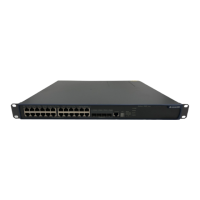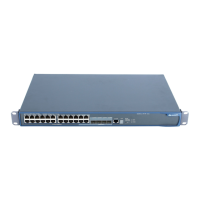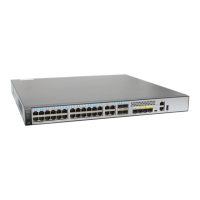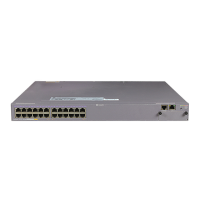Operation Manual – IRF Fabric
Quidway S5600 Series Ethernet Switches-Release 1510 Chapter 1
IRF Fabric Configuration
Huawei Technologies Proprietary
1-2
1.1.2 Introduction to RMON on IRF
The remote monitoring (RMON) configurations of the devices in a fabric are the same.
The RMON configuration performed on a device of a fabric will be automatically
synchronized to all devices in the fabric if the configuration does not conflict with those
of other devices in the fabric.
If you configure the same entry in the same RMON group for devices of a fabric to be
different values, the entry values of all the conflicting devices will adopt that of the
conflicting device with the smallest Unit ID when you synchronize the devices. Such a
mechanism eliminates configuration conflicts between the devices in a fabric.
After the device configurations converge, you can collect RMON history and statistics
data of any unit from any switch in the fabric. For detailed information about RMON,
refer to the SNMP&RMON Operation part in Quidway S5600 Series Ethernet
Switches Operation Manual.
1.2 Peer Fabric Port Detection
1.2.1 Introduction to the Peer Fabric Port Detection Function
As the basis of the IRF function, the fabric topology management (FTM) module
manages and maintains the entire topology of a fabric. The FTM module also
implements the peer fabric port detection function.
A device can join a fabric only when the following conditions are met.
z The number of the existing devices in the fabric does not reach the maximum
number of devices allowed by the fabric.
z The fabric names of the device and the existing devices in the Fabric are the
same.
z The software version of the device is the same as that of the existing devices in
the fabric.
z The device passes the security authentication if security authentication is
enabled in the fabric.
1.2.2 Work Flow of the Peer Fabric Port Detection Function
After a switch is powered on, the FTM module releases device information of the
switch through the fabric ports. The device information includes Unit ID, CPU MAC,
device type ID, fabric port information, and all fabric configuration information. The
device information is released in the form of discovery packet (DISC). A new device
can join a fabric only when its DISC packets pass the authentication performed by the
existing devices in the fabric.

